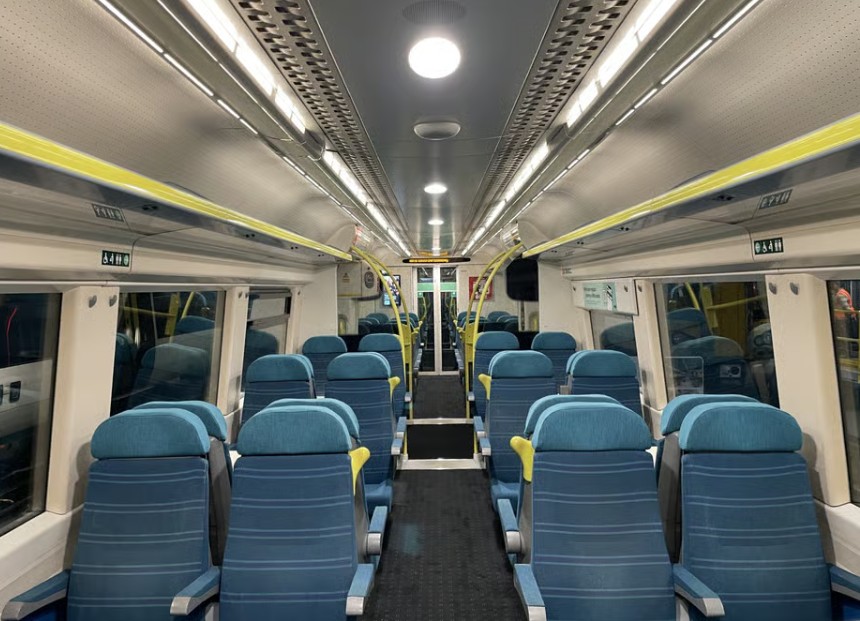£100m London Commuter Train Upgrade Keeps 300 Trains on Track for 15 More Years
More than 300 commuter trains running in and out of Victoria station have received a £100 million makeover, ensuring they remain in service for the next 15 years.
The program, known as the Aurora project, saw the refurbishment of Southern’s entire Electrostar fleet.
The final train was returned to service on Friday, marking the end of the five-year effort at Selhurst depot in south London.
Justin Lanigan, Southern’s overhaul manager, said: “This is up to the standard of brand-new trains coming online.”
The upgrade covers 1,222 carriages, including trains used on the Gatwick Express. Each train now boasts better Wi- Fi via new routers designed to support 5G in the future, USB phone-charging points at every seat, power sockets, brighter lighting, and streamlined digital information boards.
Detectors above the doors now track passenger figures, paving the way for displays that indicate which carriages have empty seats. This data will help Southern optimize capacity during peak trip times.
Safety and trustworthiness have also been improved. Front-facing CCTV observers track obstacles on the line, while a high-tech conservation system allows masterminds to check for faults ever.
This should reduce the need for trains to be returned to the depot for minor issues, keeping the line running easily.
Many of these trains date back to 2001. Those without plug sockets required the most extensive work, with all seats removed for full rewiring.
Southern and its sister companies under the GoVia Thameslink Railway (GTR) brand, Thameslink, Great Northern, and Gatwick Express, are scheduled for renationalization on 31 May next year.
The Aurora project was funded by Porterbrook, the private company that owns the trains. Around 23 of the refurbished trains are also used by Southeastern.
Ben Ackroyd, Porterbrook’s chief operating officer, said: “These trains are 25 years old and well-deserving of an upgrade, to bring them up to modern passenger expectations.
The key thing was that GTR took passenger feedback and incorporated that into the designs.
We have also invested in the technology inside the train to make the trains more reliable and improve passenger journeys.”
He added that the refurbishment had made the trains “lighter, brighter and better-connected”.
Routine work, such as repainting and replacing seat covers, has also been carried out.
Steve Lammin, GTR engineering director, highlighted the project’s scale: “Millions of passengers will experience this upgrade. It’s about putting the passenger at the heart of what we are trying to deliver.
It’s been a fantastic project, 304 trains of the Electrostar fleet. I think it’s fair to say it’s the largest UK modification package in history. On the 200th anniversary of the railways, it’s something to celebrate.”
Meanwhile, Chiltern Railways, which operates from Marylebone, unveiled its newest Mark 5A trains. These are expected to enter service next year, adding an extra 10,000 seats per day by December 2026.
The 13 new trains will serve the West Midlands, Aylesbury, and Oxford routes, replacing nearly 50-year-old carriages.
Passengers can expect enhanced Wi-Fi, USB ports, plug sockets at every seat, air conditioning, better luggage and bike storage, and digital information screens.
Rail Minister Lord Hendy said: “These trains will give a fresh look and greater capacity for Chiltern’s passengers.
This investment reflects the Government’s unwavering commitment to building a rail industry that Britain needs and deserves.”
Richard Allan, managing director of Chiltern Railways, confirmed plans for the future: “The next stage is to continue working with Network Rail and the Department of Transport on the business case to replace our 35-year-old diesel trains with battery-electric trains.”
Chiltern is developing a joint business case with Network Rail to introduce battery-electric trains by the early 2030s, partially electrifying its network and replacing remaining diesel units.






